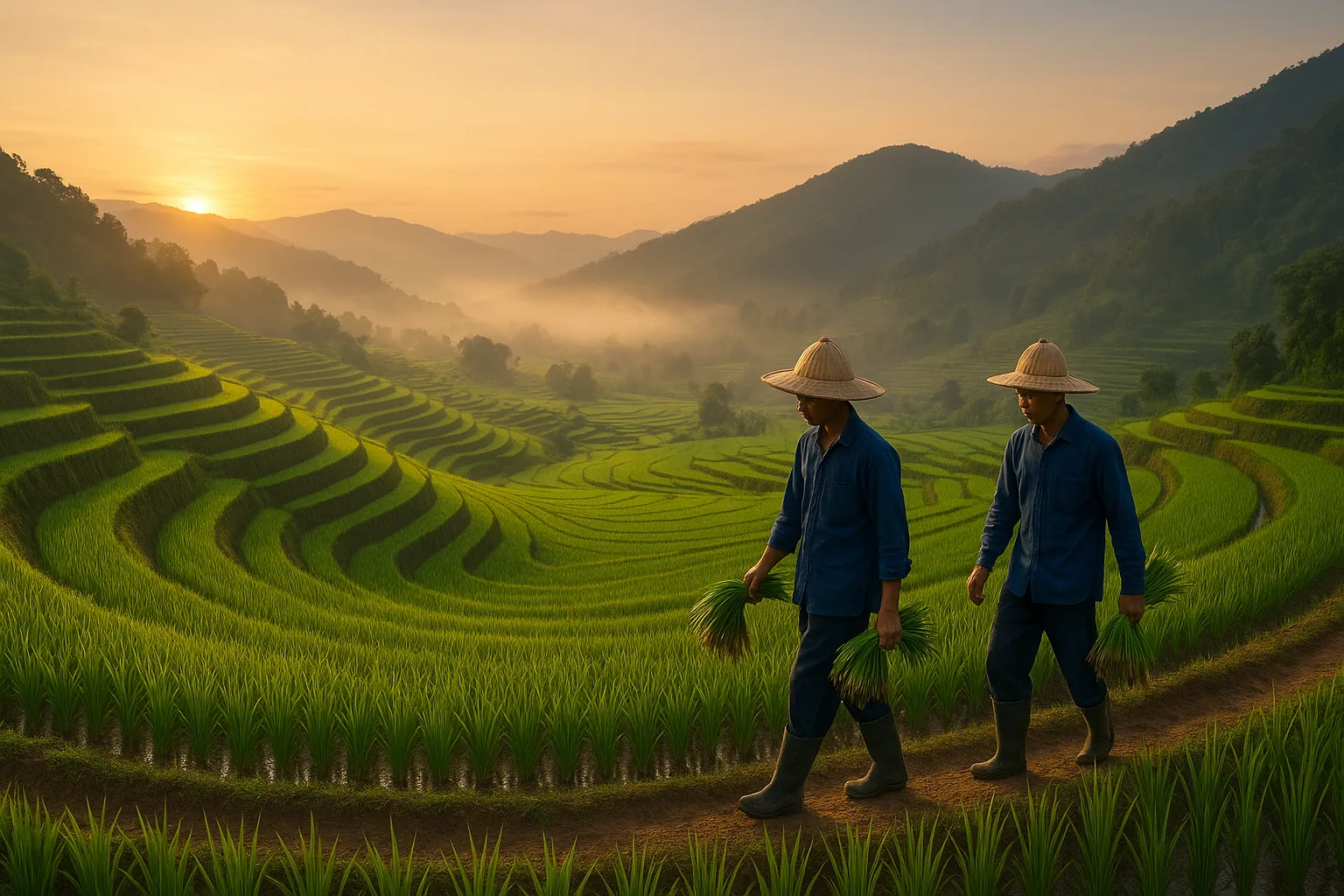
🌾Rice Culture
The sacred grain that defines Thai life, land, and identity

The sacred grain that defines Thai life, land, and identity
Ask a Thai person if they've eaten yet, and they'll likely respond "kin khao rue yang?"—literally, "have you eaten rice yet?" Not "have you eaten," but specifically rice. This linguistic detail reveals something profound: in Thailand, rice isn't just food. It's the measure of nourishment, the center of every meal, the foundation of culture itself. Without rice on the table, no matter how much else you've consumed, you haven't really eaten.
Thailand's relationship with rice stretches back thousands of years to the earliest agricultural settlements in Southeast Asia. Today, the kingdom is among the world's largest rice exporters, shipping millions of tons to every continent—primarily non-glutinous varieties including jasmine rice, with smaller but notable shipments of sticky rice. But the numbers barely capture what rice means here. It's woven into language, spirituality, festivals, family structure, and national identity in ways that make it nearly impossible to understand Thailand without understanding rice.
Drive through Thailand's central plains or northern valleys during the rainy season, and you'll see the landscape transformed into an endless patchwork of emerald paddies. Farmers wade through ankle-deep water, backs bent, hands pressing seedlings into mud. It's the same motion their ancestors made centuries ago, the same rhythm that governs rural life from June's first plantings to November's golden harvest. This cycle isn't just agricultural—it's the pulse of Thai culture.
"In Thailand, rice isn't just food. It's the measure of nourishment, the center of every meal, the foundation of culture itself."
Before farmers plant their first seedling, before they harvest their first stalk, they make offerings to Mae Phosop—the rice goddess who dwells within every grain. She's not an abstract deity worshipped in distant temples but an intimate presence in fields and kitchens. Stories say she sacrificed herself to give humans rice, and her spirit remains in the crop, demanding respect and gratitude.
This belief shapes how Thais interact with rice at every level. You never waste rice, never step over it, never treat it carelessly. Children are taught from a young age to finish every grain in their bowl, treating rice with the respect it deserves. It sounds like superstition, but it's actually practical philosophy: rice sustains life, and life should honor what sustains it. The reverence isn't about religion in the formal sense—many of the same people who make offerings to Mae Phosop also practice Buddhist rituals. It's older than Buddhism, deeper than doctrine.
Throughout the farming cycle, ceremonies mark each critical transition. Before planting, farmers construct small shrines in their fields and present flowers, incense, and food to Mae Phosop, asking her blessing. During the growing season, they sing traditional songs to encourage the rice's growth—not metaphorically but actually singing to the plants, believing their attention nourishes more than rain and sun. At harvest, they gather the first stalks with special reverence, often keeping these in the home as sacred objects that ensure next year's prosperity.
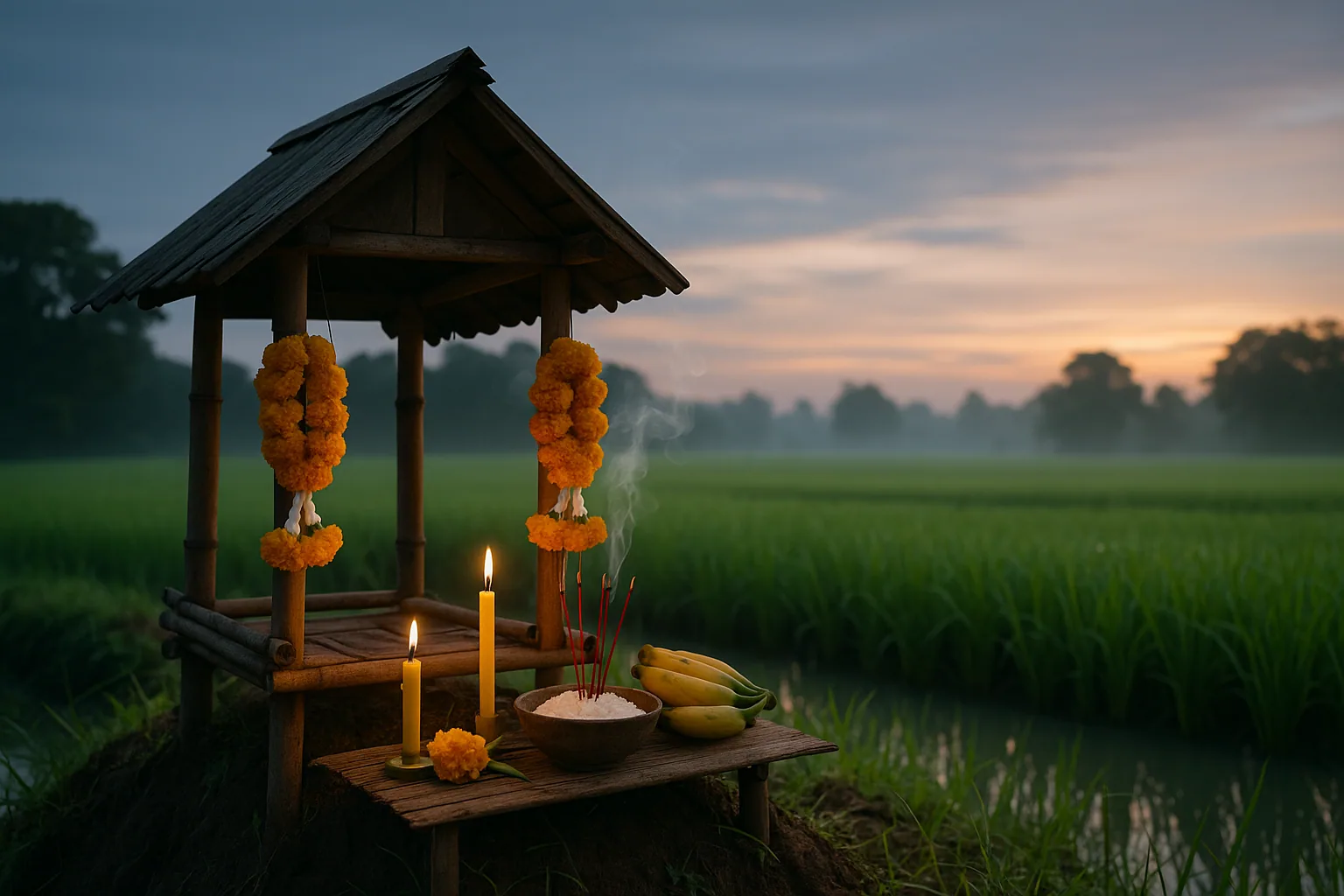

Each May, before the rainy season begins, Bangkok hosts one of Thailand's most ancient rituals: the Royal Plowing Ceremony. Dating back centuries, this Brahmin ceremony sees sacred oxen plow a ceremonial furrow while priests make predictions about the coming harvest. The oxen are offered seven different foods and drinks—rice, corn, beans, sesame, alcohol, water, and grass. Which items they consume determines whether the year will bring abundant crops, adequate rain, and agricultural prosperity.
Though held in Bangkok's royal grounds, the ceremony's conclusions affect the entire kingdom. Farmers watch the predictions and adjust their planting strategies accordingly. After the rite, onlookers collect the auspicious rice seeds scattered in the field—some are also packaged and distributed to farmers—to sow at home for good fortune. Modern Thailand may be urbanizing rapidly, but this ancient ceremony still draws crowds and media coverage, a reminder that the nation's agricultural roots run deep.
Not all rice is created equal in Thailand, and the variety matters immensely. Ask someone from Bangkok about their preferred rice, and they'll describe the fragrant, slightly sticky grains of jasmine rice—specifically Thai Hom Mali, the premium variety grown primarily in the northeast's Thung Kula Ronghai plateau. This is the rice that made Thailand famous internationally, with its distinctive floral aroma and slightly sweet flavor. It's the rice served at restaurants, sold in supermarkets, and exported worldwide as a marker of quality.
But travel to Thailand's north or northeast, and you'll discover that jasmine rice isn't even the preferred variety. Here, sticky rice (khao niao) dominates. This glutinous rice is steamed in bamboo baskets, formed into small balls with your hands, and used to scoop up spicy salads and grilled meats. It's eaten at every meal in these regions, and locals often say they don't feel full without it. The texture is completely different—chewy, dense, almost sweet—and the eating experience is tactile in a way regular rice isn't.
The division between jasmine and sticky rice regions reflects deeper cultural and historical differences. The north and northeast share ethnic ties with Laos, where sticky rice is the staple. Central and southern Thailand, influenced more by Khmer and Mon kingdoms, favor jasmine rice. These aren't interchangeable choices—they're markers of regional identity, and many Thais feel genuinely uncomfortable eating meals without their preferred rice type. When northeasterners move to Bangkok for work, they often cook sticky rice at home despite jasmine rice's prevalence in the city. It's comfort food in the deepest sense.
→ Jasmine rice accompanies most curries, stir-fries, and southern Thai dishes
→ Sticky rice pairs with northeastern (Isaan) specialties like som tam and larb
→ Rice porridge (khao tom and jok) is a classic breakfast and comfort food for illness
→ Fried rice (khao pad) transforms leftover rice into a complete meal
→ Sweet sticky rice with mango is Thailand's most famous dessert worldwide
Beyond these two main categories, Thailand grows dozens of specialty rice varieties, each with distinct characteristics. Black glutinous rice—often marketed as "forbidden rice" (a Chinese legend about grain once reserved for emperors)—is traditionally used in Thai desserts and turns purple when cooked. Brown rice, long dismissed as animal feed, has found new appreciation among health-conscious urban Thais. Red rice from northern hill tribes commands premium prices at organic markets. The diversity reflects both Thailand's agricultural sophistication and the importance of rice differentiation in Thai cuisine.
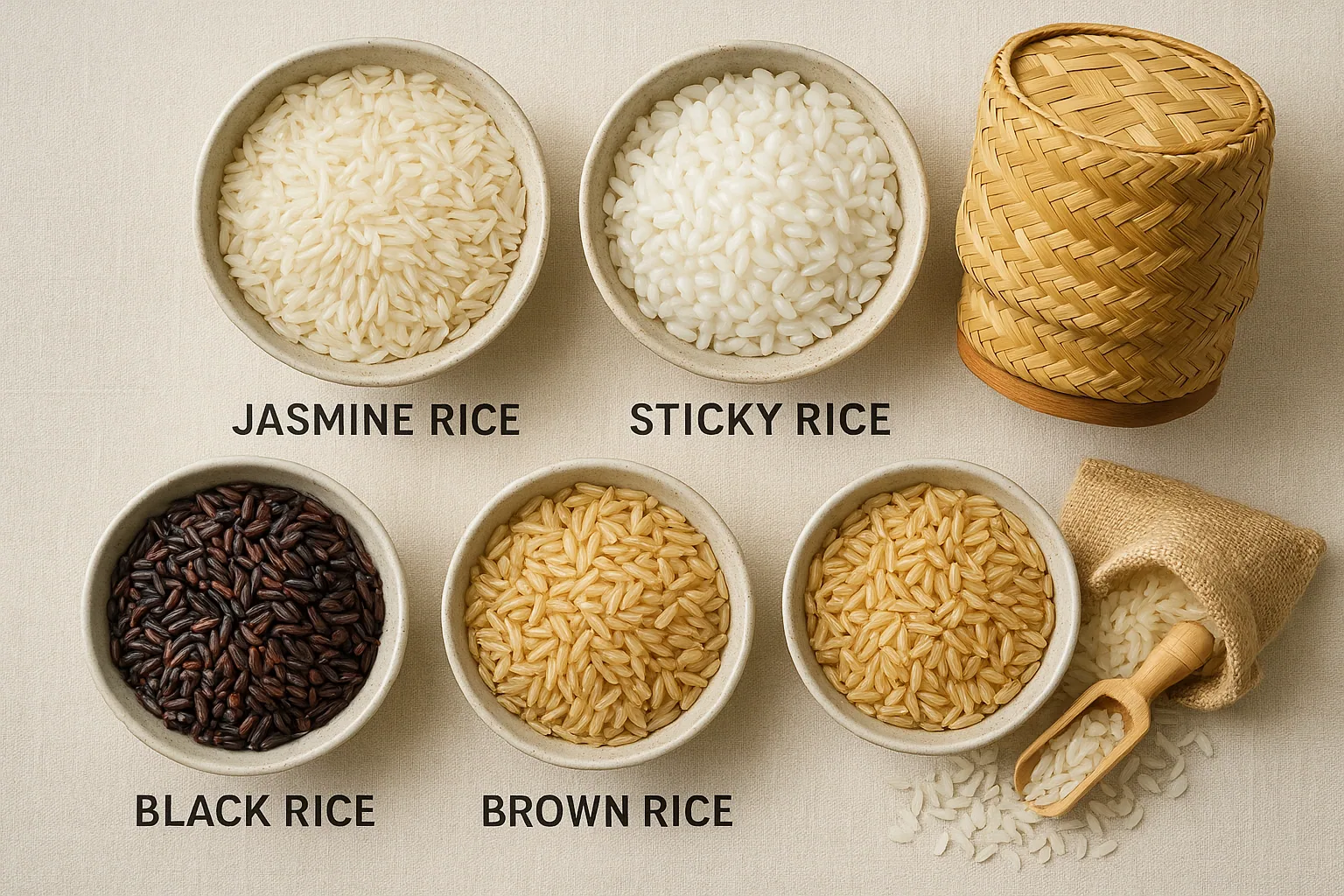
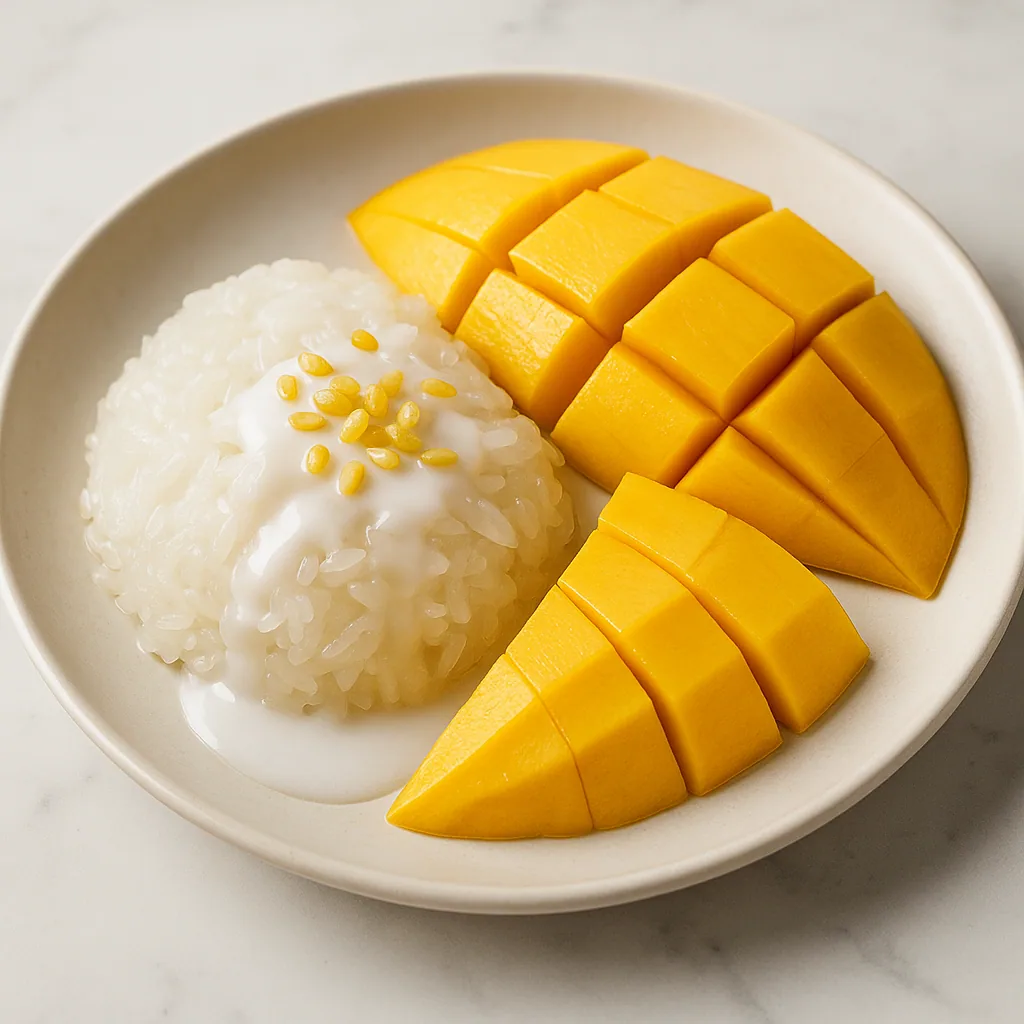
Thailand's rice farming follows the monsoon, making it as much about reading weather patterns as agricultural technique. The cycle begins in earnest during May and June, when the first heavy rains transform dried paddies into shallow lakes. Farmers prepare seed beds, nurturing young rice plants until they're ready for transplanting. Then comes the backbreaking work: wading into flooded fields, bending low to press individual seedlings into the mud, row after row, acre after acre.
Traditionally, this planting was a community affair. Villages practiced "long khek"—labor exchange where neighbors help each other plant and harvest, rotating through farms so no one faces the work alone. These planting days were also social events, featuring communal meals, traditional songs, and the kind of gossip and bonding that can only happen during shared physical labor. While mechanization has reduced this practice, it persists in many villages, particularly during harvest season when timing is critical.
Through the growing season—July to October—farmers manage water levels, watch for pests, and make offerings to Mae Phosop. The paddies transform from brown water to vibrant green as rice plants shoot upward, then gradually shift to golden yellow as the grain matures. By November and December, harvest time arrives. The fields that were green just weeks earlier now look like wheat fields, and farmers race to gather the crop before rains damage the grain.
In many villages, water buffalo remain essential to rice farming, plowing fields and pulling carts just as they have for centuries. These massive animals, once present in nearly every farming household, have decreased with mechanization but retain deep cultural significance. Farmers develop genuine affection for their buffalo, giving them names and treating them as family members. During harvest festivals, buffalo are honored alongside farmers, decorated with flowers, and given special treats—recognition of their partnership in sustaining Thai life.

Modern rice farming in Thailand exists in a strange tension between ancient tradition and contemporary pressure. Some farmers use tractors for plowing, mechanized threshers for harvest, and chemical fertilizers for yield. Others continue traditional methods, organic farming, and community labor exchange. Many mix both approaches—tractors for plowing but hand planting, chemical pesticides but offerings to Mae Phosop. It's not contradiction but adaptation, finding ways to maintain livelihoods while honoring traditions that define identity.
Thailand's festival calendar reflects the rice cycle, celebrating planting, growth, and harvest. Beyond the Royal Plowing Ceremony, dozens of local festivals honor rice throughout the year. In the northeast, the "Boon Khao Pradup Din" festival (held in August/September during the 9th lunar month) features offerings to ancestors during the rainy season. During the growing season, some villages hold "Boon Bang Fai"—rocket festivals where homemade rockets are launched to encourage rain, blending animist beliefs with Buddhist merit-making and a good dose of spectacle.
Harvest festivals are perhaps the most joyous. After months of anxious watching and hoping, the successful harvest brings visible relief and celebration. Villages hold communal feasts where the year's first rice is cooked and shared. Temple festivals feature rice-based offerings and competitions—rice pounding contests, rice cooking competitions, displays of the most beautiful rice stalks. These aren't tourist events but genuine community celebrations of survival and prosperity.
Even Thailand's most famous festival, Songkran, connects to the rice cycle. Though now celebrated as Thai New Year with massive water fights, Songkran (mid-April) marks renewal and cleansing with water rituals. While often linked symbolically to agricultural preparation, Thailand's Southwest monsoon typically begins later, around mid-May. The water splashing began as blessing rituals for good fortune and purification. The festival's timing wasn't arbitrary but aligned with traditional New Year celebrations and the anticipation of the coming growing season.
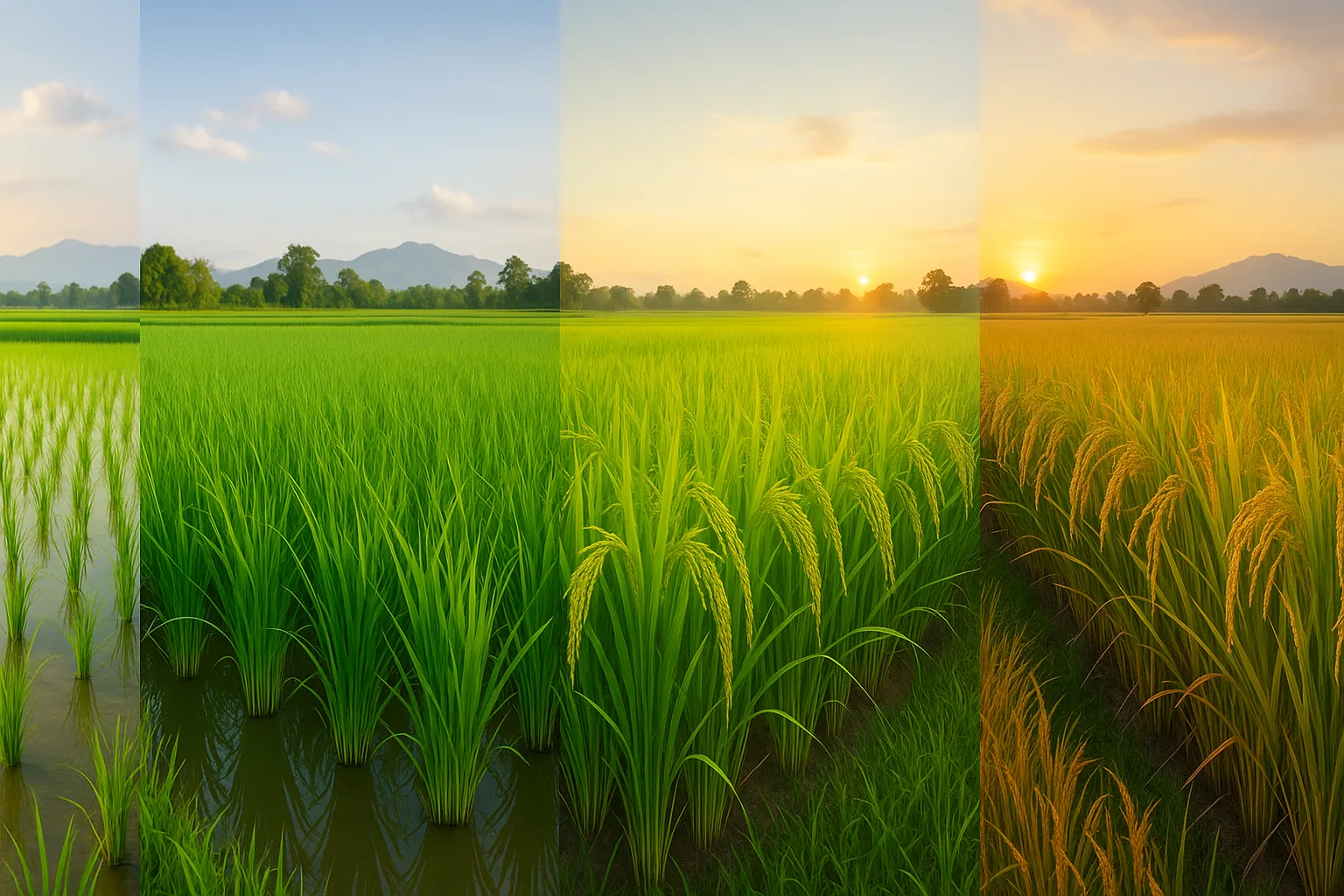
For all its cultural importance, Thai rice farming faces existential challenges. The average age of Thai farmers now exceeds 50, and young people increasingly reject farming as a viable career. They move to Bangkok, Chiang Mai, or other urban centers seeking better wages and easier work. Who can blame them? Rice farming is brutally hard labor for often minimal returns, especially when middlemen and market fluctuations can wipe out a year's profit margin.
Many farmers are trapped in debt cycles, borrowing to buy seeds and fertilizer, then selling their harvest at whatever price traders offer, only to borrow again next season at higher interest rates. Government price guarantees and subsidies help but can't solve the structural issues: global rice markets driven by the lowest price, increasing costs of inputs, climate change disrupting traditional planting schedules, and land ownership concentrated among fewer families while small farmers struggle.
Yet rice farming persists, sustained partly by those same cultural values this article describes. For many families, abandoning ancestral land feels like abandoning identity itself. The connection to land, to the cycle of planting and harvest, to Mae Phosop and the rice goddess tradition—these aren't easily severed even when economics suggest they should be. Some farmers are finding new approaches: organic rice commanding premium prices, agrotourism inviting visitors to experience planting and harvest, direct-to-consumer sales through social media bypassing exploitative middlemen.
The late King Rama IX, Bhumibol Adulyadej, dedicated much of his reign to agricultural development, launching thousands of royal projects focused on sustainable farming. His "sufficiency economy" philosophy encouraged farmers to diversify crops, reduce dependence on expensive inputs, and prioritize self-reliance over maximum yields. Many of these projects continue today, offering training in organic methods, water management, and sustainable agriculture.
These royal initiatives resonate because they align with traditional values—respect for the land, long-term thinking, community cooperation—while offering practical solutions to modern challenges. Farmers who adopt sufficiency economy principles often report reduced debt, greater stability, and renewed sense of purpose in their work.
Living in Thailand means encountering rice culture constantly, often in ways you won't immediately recognize. When your Thai colleague chooses a restaurant, they're partly choosing based on rice quality—some places are known for using premium jasmine rice, others cut costs with inferior varieties, and Thais notice. When someone offers you food, refusing completely is more offensive than refusing other dishes because rice represents life-giving nourishment itself.
Understanding rice culture helps decode broader Thai values. The reverence for Mae Phosop connects to animist beliefs that predate Buddhism. The community labor exchange reflects collectivist social structures. The farmer's status—respected in principle, often exploited in practice—mirrors tensions throughout Thai society between traditional values and modern economics. Rice farming's challenges illuminate rural-urban divides that shape Thai politics and national identity.
If you have the opportunity, visit rice paddies during planting or harvest season. Watch farmers work, notice the coordination and skill required, observe the landscape transformed by agriculture. Better yet, some farms offer experiences where visitors can try planting rice themselves—prepare for mud, mosquitoes, and profound respect for people who do this labor daily. Many Thais who grew up in farming families will happily explain the process if you show genuine interest. These conversations often reveal deep knowledge about seasons, varieties, techniques, and traditions that outsiders rarely access.
Rice in Thailand is never just rice. It's history, spirituality, economics, identity, art, and survival braided together into something irreducible. That simple question—"have you eaten rice yet?"—carries the weight of thousands of years when rice meant the difference between feast and famine, life and death. Modern Thailand may be rapidly urbanizing, but rice remains its heart. Understanding this helps you understand why certain things matter here, why traditions persist, and why something as seemingly simple as a bowl of jasmine rice can represent everything about being Thai. For more insights into the cultural traditions that shape daily life, explore our guide to Thai family structure and the communal values that sustain rural communities.
JASMINE RICE (Hom Mali)
Fragrant long-grain rice, Thailand's most famous export. Grown primarily in the Thung Kula Ronghai plateau in the northeast, served throughout central and southern Thailand. Slightly sticky when cooked, floral aroma.
STICKY RICE (Khao Niao)
Glutinous rice steamed in bamboo baskets. Staple of northern and northeastern Thailand. Eaten with hands, rolled into balls. Sweet sticky rice used in desserts.
BLACK RICE
Often marketed as "forbidden rice" (a Chinese legend about grain once reserved for emperors). In Thailand, black glutinous rice is traditionally used in desserts and turns purple when cooked. High in antioxidants.
BROWN RICE
Unmilled rice with bran layer intact. Growing popularity among health-conscious urban Thais. Higher fiber and nutrients.
Remember
Never waste rice or treat it carelessly. Each grain carries spiritual significance and represents farmers' hard labor.
May - Royal Plowing Ceremony
Ancient Brahmin ritual predicting harvest success
June-July - Planting Season
First monsoon rains, transplanting seedlings into flooded paddies
August-October - Growing Season
Paddies transform from brown to emerald green, farmers tend crops
November-December - Harvest
Golden fields, intensive labor, harvest festivals
Timing varies by region and rice variety
→ Royal Plowing Ceremony (May) - Seasonal augury at Bangkok's Sanam Luang
→ Rocket Festivals (May) - Encourage rain for planting
→ Boon Khao Pradup Din (Aug/Sep) - Rainy-season ancestor offerings in Isan
→ Harvest Festivals (Nov-Dec) - Celebrate successful crop
→ Rice Offering Days - Throughout growing season